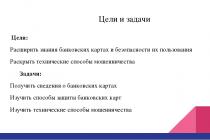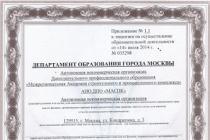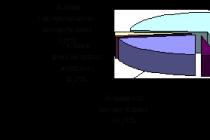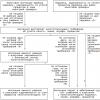The life of a market economy can be characterized as simultaneous existence in two mutually exclusive states: equilibrium and disequilibrium (dynamics).
In a market economy, all products produced (total production) must become goods (total supply), and all income (total income) must be spent (total demand) and purchased (total consumption). Only in this case will the aggregate values of effective demand and commodity supply coincide. This ideal, but practically unattainable state of a market economy is its “economic equilibrium.”
On the other hand, the market economy is in constant motion, which causes a violation of the equality of aggregate demand and aggregate supply. And although each such deviation is accompanied by many negative consequences, only through such deviations does “economic dynamics” occur - the development of a market economy. Let's look at these states in more detail.
Macroeconomic equilibrium– achieving balance and proportionality of economic processes in the national economy: production and consumption, supply and demand, production costs and results, material and financial flows.
The main condition for achieving macroeconomic equilibrium is equality between aggregate demand and aggregate supply (AD = AS).
Macroeconomic equilibrium is the only price level at which the amount of total output (goods and services) offered on the market is equal to the amount of total demand.
Various areas of economic science have assessed the problem of achieving macroeconomic equilibrium in different ways. Let's briefly look at the most important of them.
Classical theory of macroeconomic equilibrium. Classical economists (A. Smith, D. Ricardo, J.B. Say, A. Marshall and others) believed that a market economy independently copes with the efficient distribution of resources and their full use. The main tenet of this theory is Say's law, according to which the production process itself creates income exactly equal to the cost of the goods produced, i.e. supply generates its own demand (AD = AS).
The ability of a market economy to self-regulate ensures the required level of production and employment automatically (although sometimes disruptions in the economy may occur due to wars, drought, or political upheavals). Therefore, full employment is the norm of a market economy, and the best economic policy of the state is non-interference in the economy. These views dominated economic science until the 30s of the twentieth century.
Keynesian theory of macroeconomic equilibrium. The economic crises of the 1930s refuted the classical theory. The English economist John Maynard Keynes and his followers proved that a monopolistic economy is characterized by disequilibrium, it does not guarantee full employment, and therefore does not have an automatic self-regulation mechanism.
Keynes believed that aggregate demand was variable and prices were inelastic (not tending to fall as sales increased), so unemployment could persist for a long time. Hence the need for macroeconomic policies to regulate aggregate demand, which is very variable. Keynes believed that in order for the economy to be balanced and to achieve equilibrium, demand must be “effective.” The state, by supporting private investment through tax, monetary policy and government spending, compensates for the lack of “effective demand” with additional government demand and thereby helps the economy move closer to full employment.
Neoconservative theory. In the mid-1970s, Western countries experienced a decline in the growth rate of industrial production. This phenomenon resulted from:
a) another crisis of overproduction;
b) the onset (approximately 50 years after the end of the Great Depression) of the “downward” wave of the large cycle;
c) an increase in oil prices by OPEC member countries by more than 4 times, which contributed to high cost inflation with a simultaneous decline in production, the so-called stagflation (a combination of stagnation of production with inflation).
Keynesian theory also suffered a powerful blow. It became obvious that active government intervention in the economy was unable to prevent production declines. This theory was replaced by the neoconservative movement, which again advocated state non-interference in the economic activities of firms. A model of macroeconomic regulation was developed, based on the revival of market self-regulation and stimulation of private entrepreneurship. In accordance with the recommendations of neoconservatives, the economic policies of the USA, Great Britain, Germany and a number of other countries were based on the principle of “effective supply” - encouraging private business. To make free enterprise more profitable, taxes on profits and on labor income were significantly reduced. The state noticeably reduced its intervention in economic affairs, partial privatization of state-owned enterprises began - selling them to private individuals, transforming them into joint-stock companies. In many countries, economic planning was noticeably curtailed and funding for social programs was reduced. The measures taken made it possible to significantly reduce the state budget deficit, reduce the amount of money in circulation, while the inflation rate fell by 3–4 times, and the pace of economic development increased.
But the model of neoconservative economic regulation did not save the West from declines in production and inflation. In 1979–1981 a new economic crisis broke out. The search for a new macroeconomic regulator has begun.
Mixed management. A critical comparison of state (Keynesian) and market (neoconservative) regulators convincingly proved the inferiority of both exclusively market and only state economic mechanisms. The type of mixed management of the national economy was proposed by Nobel Prize laureate Paul Samuelson (USA). This macroeconomic regulator has the following specific features.
1. it organically combines the stability of public administration, necessary to meet public needs (social sphere, non-market sector), and the flexibility of market self-regulation, which is required to satisfy rapidly changing personal needs.
2. mixed management makes it possible to optimally combine macroeconomic goals: economic efficiency, social justice and stability of economic growth.
3. the new regulator is able to balance aggregate demand and aggregate supply and thereby overcome the asymmetry of the concepts of effective demand of Keynesianism and effective supply of neoconservatives.
This type of macroeconomic regulation today prevails in all developed countries with market economies, although there are various variations:
With minimal government participation in regulating the economy (USA);
With the maximum permissible government regulation (Sweden, Austria, Germany, Japan, etc.).
Types of macroeconomic equilibrium:
1. General and partial equilibrium. General equilibrium is understood as the interconnected equilibrium of all national markets, i.e. the balance of each market separately and the maximum possible coincidence and implementation of the plans of economic entities. When a state of general economic equilibrium is achieved, economic entities are completely satisfied and do not change the level of demand or supply to improve their economic situation.
Partial equilibrium is equilibrium in individual markets that are part of the national economic system.
2. Equilibrium can be short-term (current) and long-term.
3. Equilibrium can be ideal (theoretically desired) and real. The prerequisites for achieving ideal equilibrium are the presence of perfect competition and the absence of side effects. It can be achieved provided that all participants in economic activity find consumer goods on the market, all entrepreneurs find factors of production, and the entire annual product is fully sold. In practice, these conditions are violated. In reality, the task is to achieve a real equilibrium that exists in the presence of imperfect competition and the presence of external effects and is established when the goals of participants in economic activity are not fully realized.
4. Equilibrium can also be stable and unstable. Equilibrium is called stable if, in response to an external impulse causing a deviation from equilibrium, the economy independently returns to a stable state. If, after an external influence, the economy cannot self-regulate, then the equilibrium is called unstable. The study of stability and conditions for achieving general economic equilibrium is necessary to identify and overcome deviations, i.e. to carry out an effective economic policy for the country.
Disequilibrium means that there is no balance in various spheres and sectors of the economy. This leads to losses in gross product, a decrease in household incomes, inflation, and unemployment. To achieve an equilibrium state of the economy and prevent undesirable phenomena, specialists use macroeconomic equilibrium models, the conclusions from which serve to substantiate the state’s macroeconomic policy.
The concept of macroeconomic equilibrium
As you know, in any market economic system, all produced products must become goods, and all income must be spent on these goods. Only in this case will all these aggregate quantities (effective demand and aggregate supply) coincide. This balanced state is called “macroeconomic equilibrium”.
Any economy can be in two mutually exclusive states: equilibrium and disequilibrium (dynamics). In other words, it is in constant motion, and therefore the equality of aggregate demand and aggregate supply is often violated. This is the reason for the emergence of macroeconomic imbalances: inflation, unemployment, decline in production and imbalance in the balance of payments. And although this may be accompanied by very negative social consequences, through such deviations from equilibrium the economy remains dynamic, and therefore develops.
Definition 1
Macroeconomic equilibrium– a balanced state of the economic system as a single integral organism and at the same time, a fundamental problem of macroeconomic analysis.
In macroeconomic equilibrium, correspondence must be achieved between the following basic economic parameters:
- aggregate demand and aggregate supply;
- production and consumption;
- savings and investments;
- commodity mass and its monetary equivalent;
- markets for capital, labor and consumer goods.
The main condition for achieving macroeconomic equilibrium is equality between aggregate demand ($AD$) and aggregate supply ($AS$). That is, the equality $AD = AS$ must be satisfied (Fig. 1):
Figure 1. Classical macroeconomic equilibrium model. Author24 - online exchange of student works
As can be seen from Fig. 1, macroeconomic equilibrium is the “place” where demand ($AD$) and supply ($AS$) “meet”, intersecting at point $M$. This point means the equilibrium volume of production, and, at the same time, the equilibrium price level. Thus, the economic system is in an equilibrium state at such values of the real national product and at such a price level at which the volume of aggregate demand will correspond to the volume of aggregate supply.
Types of macroeconomic equilibrium
Macroeconomic equilibrium can be of different types: partial, both general and real.
Partial equilibrium is understood as equilibrium in individual commodity markets of the national economy. This type of macroeconomic equilibrium was studied in detail in his works by the famous economist A. Marshall.
At the same time, general equilibrium is equilibrium as a single interconnected system, which is formed by all market processes occurring in the economy.
Real macroeconomic equilibrium, as the name suggests, occurs under conditions of imperfect competition, as well as when the market is exposed to external factors.
Note 1
The general macroeconomic equilibrium is considered stable if, after being disrupted, it is able to be restored with the help of market forces. If active government intervention is required to restore equilibrium, then the equilibrium will be considered unstable. L. Walras is considered the founder of the theory of general economic equilibrium. According to Walras, with general equilibrium, balance is achieved simultaneously in all markets: consumer goods, money, labor market, etc. A necessary condition is the flexibility of the system of relative prices.
In an economic system, general equilibrium can be achieved both in the short term (the intersection of the lines $AD$ and $SRAS$) and in the long term (the intersection of $AD$ and $LRAS$) (Fig. 2). In the short term, equilibrium is achieved by the economy with underemployment of resources. The long-term period implies equilibrium at full employment of resources (that is, in the presence of only the natural rate of unemployment). General macroeconomic equilibrium implies that total spending equals total national output and investment (I) equals saving ($S$). In addition, the magnitude of the demand for money must correspond to the magnitude of the supply of money in the economic system.
If there is a disequilibrium in the economy that is close to the state of full employment of resources (point $A$ in Fig. 2), caused by a change in aggregate demand from $AD_1$ to $AD_2$, the economy will first reach its short-term equilibrium (point $B$) , and then reaches the long-term (point $C$). This desire of the economy to reach a state of stable equilibrium (to point $C$) occurs sequentially through price changes.

Figure 2. General macroeconomic equilibrium. Author24 - online exchange of student works
A change in aggregate demand from $AD_1$ to $AD_2$ can occur, for example, due to an increase in money supply in the economy. When short-term equilibrium is reached (point $B$), the price level remains unchanged for some time, since producers can increase supply due to inventories, as well as the involvement of additional reserve capacities in production. However, the ongoing pressure of aggregate demand will continue to stimulate production growth. This will inevitably lead to an increase in average costs, since the increase in demand for resources in conditions of their full employment will contribute to an increase in the price of labor (wages).
Further, increased average costs will begin to restrain the growth of production volumes, which will reduce aggregate supply. In turn, this will contribute to rising prices for goods and services. This price increase will restrain the growth of aggregate demand (in Fig. 2, the value of aggregate demand decreases, moving along the $AD_2$ curve from point $B$ to point $C$). The final result of the economic system's adaptation to a change in aggregate demand from $AD_1$ to $AD_2$ will be its achievement of a state of long-term equilibrium (at point $C$) with the same volume of national production, but at a higher price level.
Economic practice confirms that, regardless of the reasons causing a change in aggregate demand and a violation of the original long-term equilibrium, in the long term the economy, through self-organization and self-regulation, returns to the level of potential GNP, given by the available amount of resources and technology.
In conditions of underemployment of resources, an increase in aggregate demand over a long period of time can stimulate an increase in the value of aggregate supply, up to potential GNP. However, further growth in aggregate demand will cause the reaction described above (Fig. 2).
In the event of a decrease in aggregate demand, caused, for example, by a decrease in the money supply or an increase in taxes, the $AD$ curve will shift to the left, which will indicate a decrease in GNP in the short term with a constant price level. Subsequently, a downward change in prices, caused by rising unemployment, lower wage rates (decrease in average costs), will gradually return the economy to the level of potential GNP (movement along the $AD_3$ curve to point $D$). However, in a real economy, the prices of goods and the price of labor, due to imperfect competition, tend to increase rather than decrease, i.e. they are not downward flexible, so national output may recover to potential levels, but at a higher price level.
4.1 Concept and types of macroeconomic equilibrium
In its most general form, macroeconomic equilibrium is the balance and proportionality of the main parameters of the economy, i.e. a situation where business entities have no incentive to change the existing state of affairs. This means that proportionality is achieved between production and consumption, resources and their use, factors of production and their results, material and financial flows, supply and demand. In a market economy, equilibrium is the correspondence between the production of goods and the effective demand for them, i.e. This is an ideal situation when exactly as much product is produced as can be bought at a given price. It can be achieved by limiting the needs for economic goods, i.e. by reducing effective demand for goods and services, or by increasing and optimizing the use of resources.
Macroeconomic equilibrium is classified into several types.
First, general and partial equilibrium are distinguished. General equilibrium is understood as the interconnected equilibrium of all national markets, i.e. the balance of each market separately and the maximum possible coincidence and implementation of the plans of economic entities. When a state of general economic equilibrium is achieved, economic entities are completely satisfied and do not change the level of demand or supply to improve their economic situation.
Partial equilibrium is equilibrium in individual markets that are part of the national economic system.
There is also complete economic equilibrium, which represents the optimal balance of the economic system. In reality, it is unattainable, but acts as an ideal goal of economic activity.
Secondly, equilibrium can be short-term (current) and long-term.
Thirdly, equilibrium can be ideal (theoretically desired) and real. The prerequisites for achieving ideal equilibrium are the presence of perfect competition and the absence of side effects. It can be achieved provided that all participants in economic activity find consumer goods on the market, all entrepreneurs find factors of production, and the entire annual product is fully sold. In practice, these conditions are violated. In reality, the task is to achieve a real equilibrium that exists in the presence of imperfect competition and the presence of external effects and is established when the goals of participants in economic activity are not fully realized.
Equilibrium can also be stable or unstable. Equilibrium is called stable if, in response to an external impulse causing a deviation from equilibrium, the economy independently returns to a stable state. If, after an external influence, the economy cannot self-regulate, then the equilibrium is called unstable. The study of stability and conditions for achieving general economic equilibrium is necessary to identify and overcome deviations, i.e. to carry out an effective economic policy for the country.
Disequilibrium means that there is no balance in various spheres and sectors of the economy. This leads to losses in gross product, a decrease in household incomes, inflation, and unemployment. To achieve an equilibrium state of the economy and prevent undesirable phenomena, specialists use macroeconomic equilibrium models, the conclusions from which serve to substantiate the state’s macroeconomic policy.
Let us briefly describe some models of macroeconomic equilibrium.
The first model of macroeconomic equilibrium is considered to be the model of F. Quesnay - the famous “Economic Tables”. They are a description of simple reproduction using the example of the French economy of the 18th century.
One of the first to develop was the model of L. Walras, a Swiss economist and mathematician, who tried to find out on the basis of what principles the interaction of prices, costs, volumes of demand and supply in various markets is established, whether the equilibrium is stable, and also to answer some other questions.
Walras used a mathematical apparatus. In his model, he divided the world into two large groups: firms and households. Firms act on the factor market as buyers and on the consumer goods market as sellers. Households, which own factors of production, act as their sellers and at the same time buyers of consumer goods. The roles of buyers and sellers are constantly changing. In the process of exchange, the expenses of producers of goods turn into household expenses, and all household expenses turn into income of firms.
The prices of economic factors depend on the size of production, demand, and therefore on the prices of manufactured goods. In turn, prices for goods produced in society depend on the prices of production factors. The latter must correspond to the costs of firms. At the same time, firms' income must be matched with household expenditures.
Having constructed a rather complex system of interconnected equations, Walras proves that the equilibrium system can be achieved as a kind of “ideal” towards which a specific market strives. Based on the model, Walras' law was obtained, which states that in a state of equilibrium, the market price is equal to marginal cost. Thus, the value of a social product is equal to the market value of the production factors used to produce it, aggregate demand is equal to aggregate supply, price and production volume do not increase or decrease.
The state of equilibrium, according to Walras, presupposes the presence of three conditions:
1) supply and demand for factors of production are equal, a constant and stable price is established for them;
2) supply and demand for goods and services are also equal and are sold on the basis of constant, stable prices;
3) prices of goods correspond to production costs.
Walras's model gives a simplified, conventional picture of the national economy and does not show how equilibrium is established in dynamics. It does not take into account many social and psychological factors that affect supply and demand in reality. Thus, the model considers only already established markets with established infrastructure.
At the same time, Walras's concept and his theoretical analysis provide the basis for solving more specific practical problems related to the disruption and restoration of balance.
In the 20th century other equilibrium models have been created.
Let's consider a neoclassical model of economic equilibrium based on the relationship between investment and savings at the macro level. An increase in income stimulates an increase in savings; converting savings into investment increases output and employment. Then incomes increase again, and with them savings and investments. The correspondence between aggregate demand and aggregate supply is ensured through flexible prices and a free pricing mechanism. According to the classics, price not only regulates the distribution of resources, but also contributes to the resolution of disequilibrium situations. According to this theory, in each market there is one key variable (price P, interest r, wage W/P) that ensures market equilibrium. Equilibrium in the goods market (through the demand and supply of investments) is determined by the interest rate. In the money market, the determining variable is the price level. The correspondence between supply and demand in the labor market is regulated by the value of real wages.
The classics believed that the transformation of household savings into investment expenditures of firms occurs without any special problems and government intervention is unnecessary. However, in reality, there is a gap between the savings of some and the use of these funds by others, because if part of the income is set aside in the form of savings, then it is not consumed. In order for consumption to grow, savings should not lie idle, they should be transformed into investments. If this does not happen, then the growth of the gross product is inhibited, which means that incomes decrease and demand decreases.
Savings disrupt the macroequilibrium between aggregate demand and aggregate supply. Relying on the mechanism of competition and flexible prices does not work under certain conditions. If investments are greater than savings, then there is a danger of inflation, and if less, the growth of the gross product is inhibited.
(Materials are based on: E.A. Maryganova, S.A. Shapiro. Macroeconomics. Express course: textbook. - M.: KNORUS, 2010. ISBN 978-5-406-00716-7)
Macroeconomic equilibrium - This is a state of the national economy when the use of limited economic resources to create goods and services and their distribution among various members of society are balanced, i.e. there is an overall proportionality between resources and their use; factors of production and the results of their use; production and consumption; supply and demand; material and financial flows. Achieving complete equilibrium is an economic ideal, since in real life economic crises and incomplete or inefficient use of resources are inevitable. In economic theory, the macroeconomic ideal is the construction of general equilibrium models of the economic system.
Macroeconomic models are formalized (logical, graphical) descriptions of various economic phenomena and processes in order to identify functional relationships between them. Despite the fact that in practice there are various violations of the requirements of such a model, knowledge of theoretical models of macroeconomic equilibrium allows us to determine specific factors of deviations of real processes from ideal ones and find ways to realize the most optimal state of the economy. In economic science, there are quite a lot of models of macroeconomic equilibrium, reflecting the views of different directions of economic thought on this problem:
- F. Quesnay's model of simple reproduction using the example of the French economy of the 18th century;
- classical model of macroeconomic equilibrium;
- model of general economic equilibrium under conditions of perfect competition by L. Walras;
- schemes of capitalist social reproduction (model of K. Marx);
- J. Keynes's short-term economic equilibrium model;
- input-output model by V.V. Leontiev.
Aggregate demand and aggregate supply
When developing macroeconomic equilibrium models, significant development, along with the construction of market-structured models (L. Walras model), was given to an approach that analyzes the conditions for ensuring equality between aggregate demand and aggregate supply in the national economy. To reveal the patterns of macroeconomic equilibrium, it is necessary, first of all, to formulate the concepts of aggregate demand and aggregate supply, since all changes in the national economy are associated with their changes.
Aggregate demand
Under aggregate demand refers to the sum of all individual demands for final goods and services offered on the product market. Aggregate demand consists of consumer spending (aggregate household demand), investment spending by businesses, government spending, and net export spending. Some elements of aggregate demand are relatively stable, such as consumer spending; others are more dynamic, particularly investment spending. The aggregate demand curve (Figure 12.1) shows the quantity of goods and services that consumers are willing to purchase at the appropriate price level. It will give such options for combining the volume of production of goods and services and the general price level in the economy, at which
Rice. 12.1.
of which the commodity and money markets are in equilibrium.
In macroeconomics, the level of aggregate demand as aggregated monetary demand on the elements of GNP is influenced by two main factors: the amount of money in the economy (M) and the speed of its turnover (V). The influence of all other factors of demand for an individual product ultimately comes down to changes in these factors. The negative slope of the aggregate demand curve can be explained as follows: the higher the price level (P), the lower the real cash reserves (M/R), and, consequently, the quantity of goods and services for which demand is lower (Q). The inverse relationship between the amount of aggregate demand and the price level is also associated with the interest rate effect, the wealth effect and the effect of import purchases. Thus, when prices rise, the demand for money and the interest rate increase. An increase in the cost of credit leads to a decrease in consumer and investment spending and, accordingly, to a decrease in the volume of aggregate demand. Rising prices also reduce the real purchasing power of accumulated financial assets with a fixed value (bonds, fixed-term accounts) and encourage their owners to reduce expenses. An increase in prices within the country, while import prices remain unchanged, shifts part of the demand from domestic goods to imported goods and reduces exports, which also leads to a fall in aggregate demand in the economy.
When analyzing general economic equilibrium, an important role is played by consideration of the relationship between the national product and the main components of aggregate demand. As the monetary income of the population grows, which is a factor in aggregate demand, saving. They can be represented as the difference between income and consumption (consumer spending). In economic theory, to analyze the role of consumption and savings in ensuring macroeconomic equilibrium, the concepts of consumption and savings functions were introduced. Consumption function shows the ratio of consumer spending to income in their dynamics. The same is considered and the saving function, which shows the ratio of family savings to its income in their dynamics. The trend in changes in the amount of consumption of the population as income grows is characterized by the marginal propensity to consume: it shows what part of the additional income goes to increase consumption. By analogy, the marginal propensity to save shows what part of the additional income the population uses for additional savings when the amount of income changes. Obviously, the main factor influencing consumption and saving levels is income. In addition, taxes, prices for goods and services, and the volume of supply in the market influence consumption and savings.
Aggregate offer
This is the sum of all individual offers. Total supply represents the monetary value of the total amount of all final goods and services offered for sale. It consists of wages, rent, interest and profit. The aggregate supply curve shows what volume of aggregate output can be offered to the market by producers at certain values of the general price level in the economy (Fig. 12.2). The shape of the aggregate supply curve is interpreted differently by the classical and Keynesian schools.

Rice. 12.2.
Segment I characterizes supply under conditions of under-employment, segment III determines aggregate supply at full employment, and segment II characterizes supply under conditions approaching full employment.
The aggregate supply is influenced by the same factors (technical and technological base of production, production costs) that cause changes in the market for an individual product.
Macroeconomic equilibrium presupposes equality of the volume of aggregate demand and aggregate supply. In reality, there are quite a lot of options for changes in aggregate demand and aggregate supply. Thus, with an increase in aggregate demand, prices, production volumes, and national income increase. A decline in aggregate demand is accompanied by a decline in prices, output and national income. Increasing aggregate supply leads to increased production and lower prices. The reduction in supply, as well as production volume, is accompanied by an increase in prices. Thus, as a result of constant fluctuations in aggregate demand and aggregate supply, equilibrium at the macro level is very rarely achieved. The problem of achieving macroeconomic equilibrium by the national economy is considered by representatives of various areas of economic science, as already noted, in different ways.
The problem of macroeconomic equilibrium is a central problem in macroeconomics courses. Under macroeconomic equilibrium usually understand the equilibrium of the entire economic system as a whole, which characterizes the balance and proportionality of all economic processes. It is divided into ideal and real.
Perfect Balance is achieved with the full implementation of the economic interests of economic entities in all sectors and spheres of the economy. It assumes the existence of conditions of perfect competition and the absence of externalities.
Real balance is established in the economy in conditions of imperfect competition and taking into account external factors influencing the market environment.
Aggregate demand and aggregate supply
Economic equilibrium is based on the correspondence between the supply of resources and the demand for them, between the production of goods and effective demand, between savings and investments. Macroeconomic equilibrium is achieved when the economy of a state does not suffer from such destructive ailments as inflation, unemployment, etc. Achieving macroeconomic equilibrium is the basis of the economic policy of every state.
In macroeconomics, several models are used to determine macroeconomic equilibrium. The model of aggregate demand and aggregate supply is the basis for studying general equilibrium, fluctuations in the volume of national production and the general price level, the causes and consequences of their changes.














